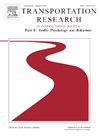西澳大利亚珀斯市区骑行者和骑自行车者的危险行为和法规遵从
IF 4.4
2区 工程技术
Q1 PSYCHOLOGY, APPLIED
Transportation Research Part F-Traffic Psychology and Behaviour
Pub Date : 2025-06-17
DOI:10.1016/j.trf.2025.06.012
引用次数: 0
摘要
电动滑板车是一种可骑的电动设备,比如滑板车或滑板车。2021年,新的可穿戴设备法规在西澳大利亚州生效。为了了解这些法规是如何被遵守的,以及与电子出行相关的行为、经历和看法,我们对珀斯大都市的电子出行者进行了观察性和拦截性调查。这些调查分别在2022年和2023年进行,分别在新规定出台后的12个月和24个月进行。在这两年中,所有设备(包括自行车)的头盔平均使用率约为90%。然而,不同设备类型的头盔使用情况差异很大。与骑自行车的人相比,骑滑板车的人不戴头盔的可能性大约是骑自行车的人的1.6倍,骑滑板车的人不戴头盔的可能性大约是骑滑板车的人的2.5倍,骑电动轮滑的人不戴头盔的可能性大约是骑自行车的人的3.4倍。大约15%的骑车人承认在某些时候没有戴头盔。2023年的观察性调查显示,与2022年的调查相比,电动滑板车的头盔合规性有所下降,尽管骑车者的头盔合规性没有变化。共享设备使用者的头盔不合规率是私人设备使用者的4倍。在2022年至2023年的调查中,持续存在着对法规缺乏认识、不遵守法规和危险行为的现象,这表明需要采取额外的干预措施来解决这些问题。特别是,探索为什么共享设备的头盔不合规似乎有所增加,这将是有价值的。本文章由计算机程序翻译,如有差异,请以英文原文为准。
Risky behaviour and regulation compliance in eRiders and cyclists in metropolitan Perth Western Australia
ERideables are electric rideable devices, such as a scooter or skateboard. In 2021, new eRideables regulations came into effect in Western Australia. To understand how these regulations were being complied with, and the kinds of behaviours, experiences and perceptions associated with eRideables, we conducted an observational and intercept survey of eRiders in metropolitan Perth. The surveys were conducted in 2022 and then again in 2023 and were timed to occur 12 months, and then 24 months, after the introduction of the new regulations. In both years overall observed helmet use averaged across all devices (including bicycles) was around 90 %. However, helmet use varied substantially across device type. Compared to cyclists, eScooter riders were around 1.6 times more likely to be unhelmeted, eSkateboarders were around 2.5 times more likely to be unhelmeted, and eWheel riders were around 3.4 times more likely to be unhelmeted. Around 15 % of eRiders admitted to not using a helmet at some point. The 2023 observational survey shows a decline in eScooter helmet compliance compared to the 2022 survey despite no change in cyclists’ helmet compliance being observed. Shared device riders were observed to be helmet non-compliant around 4 times more often than private device riders. The persistence, between the 2022 and 2023 survey, of a non-trivial lack of awareness of the regulations, noncompliance with the regulations, and risky behaviour, suggest that additional interventions are required to address these issues. In particular, there would be value in exploring specifically why there appears to be an increase in helmet noncompliance for shared devices.
求助全文
通过发布文献求助,成功后即可免费获取论文全文。
去求助
来源期刊
CiteScore
7.60
自引率
14.60%
发文量
239
审稿时长
71 days
期刊介绍:
Transportation Research Part F: Traffic Psychology and Behaviour focuses on the behavioural and psychological aspects of traffic and transport. The aim of the journal is to enhance theory development, improve the quality of empirical studies and to stimulate the application of research findings in practice. TRF provides a focus and a means of communication for the considerable amount of research activities that are now being carried out in this field. The journal provides a forum for transportation researchers, psychologists, ergonomists, engineers and policy-makers with an interest in traffic and transport psychology.

 求助内容:
求助内容: 应助结果提醒方式:
应助结果提醒方式:


